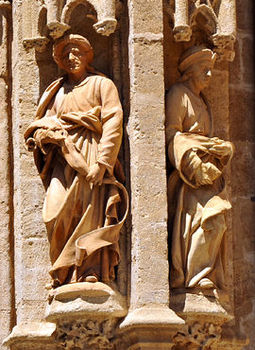Take a look at our new short article "When Faith Falters" in the Faith Survival Kit section today. The article may deal with wavering faith, but its lesson is actually very encouraging.
|
Does your faith always run at 100%, or do you experience cracks and strains in your belief at times? Are you able to maintain a steady trust in God whatever happens, or do you sometimes falter when things get bad? The answer to these questions is the same for all of us. All Christians experience occasional times of weakness in our faith, but what does this mean – does such faltering indicate that we really don't have faith at all, or is it something else? The answer is clear. The Bible gives a number of examples of individuals whose belief faltered – but who still went on to accomplish great deeds of faith.
Take a look at our new short article "When Faith Falters" in the Faith Survival Kit section today. The article may deal with wavering faith, but its lesson is actually very encouraging.  Those of you who are regular readers at our websites know how we recommend the use of BibleGateway.com for Bible reading, online translation comparison, topic searches, and all aspects of Bible study. Well, the Bible Gateway site just got a major new format with many additional helpful tools and options. If you haven't already checked out the new BibleGateway.com be sure to do so – and see our revised guide to using BibleGateway.com for even more effective study. We are resuming our normal blog schedule now that we have completed our website work and the preparation of a number of new articles. Look for new posts and articles each week!
 Grains of sand magnified 250 times Grains of sand magnified 250 times Occasionally, the fact that the population of Earth is now well over 7 billion sinks into my mind. It usually takes some kind of Infographic to help me even begin to comprehend a billion, let alone 7 billion, but at those times I get close it’s easy to begin to see how small and insignificant we really are. It’s even hard to find an analogy to put the understanding in perspective, but seeing ourselves as grains of sand on an ocean beach, or in a great desert, brings the point home pretty well. It’s an analogy that God Himself used in promising that the descendants of Abraham would be almost innumerable: “I will surely bless you and make your descendants as numerous as the stars in the sky and as the sand on the seashore” (Genesis 22:7). Those living in the biblical age had no idea how vast the universe really is, of course, but they could see the vast number of stars visible to their own eyes and could certainly visualize the vastness of numbers involved in comparing humans to grains of sand. It’s a simple analogy, but the more we grasp it, perhaps the harder it is not to feel totally insignificant. Being one of untold numbers of teeming humans is one thing, but sand particles all look alike, right, and the grains of sand analogy really can make one feel like a faceless speck if we think about it overly much. That’s why I love the picture that accompanies this blog post. It came to me on twitter courtesy of @WOWfactsoflife (via blogger Ann Bowyer who retweeted it), and it immediately caught my attention and imagination. It shows grains of sand from a sea shore magnified under a microscope 250x, and it makes the point (for me totally unrealized) that grains of sand are in fact different. The grains may be made of shell, stone, coral, or other substances and they are not only often vastly different, but they are also all unique. We know that the countless stars are different, and every elementary-schooler learns that each snowflake is different, but seeing that every grain of sand is different somehow made the point to me of the variety in creation more than anything else might have done. These grains of sand expand the analogy to make the point that God’s promise to Abraham was not of countless, faceless masses of descendants, but of billions and billions who are all individuals in the eyes of God. And that’s just on the outside! Although the grain of sand was the smallest particle known in the biblical world, we know through modern physics that each grain of sand contains, of course, an atomic and sub-atomic universe with its own characteristics. The line “To see a world in a grain of sand” from the poem “Auguries of Innocence” by William Blake comes to mind; and we can understand through the microscope, and through physics theory, that every grain of sand is different on the outside and on the inside. It’s an analogy that helps us realize we may be grains of sand, but to the God who made the Universe in all its macro and micro cosmic levels, we are indeed unique. So being analogous to a grain of sand is not as dull as you might have thought, and helps dispel the idea of our destiny as being part of a faceless multitude in standard issue, same size white robes. The idea of spending eternity getting to know not only God, but also all those unique grains of sand who become part of the family of God is an amazing concept - a thing of infinite as well as eternal variety.  The Gospels of Matthew and Mark both tell the story of how Jesus cursed a fig tree which had no fruit just outside of Jerusalem. Both accounts are examples of the importance of the biblical and cultural context in understanding the words and deeds attributed to Jesus. The account in Matthew 21 is compressed to the essential details, so we will examine Mark’s fuller account of the cursed tree: “The next day as they were leaving Bethany, Jesus was hungry. Seeing in the distance a fig tree in leaf, he went to find out if it had any fruit. When he reached it, he found nothing but leaves, because it was not the season for figs. Then he said to the tree, 'May no one ever eat fruit from you again.' And his disciples heard him say it …. [the story continues with Jesus cleansing the temple] … In the morning, as they went along, they saw the fig tree withered from the roots. Peter remembered and said to Jesus, 'Rabbi, look! The fig tree you cursed has withered!' 'Have faith in God,' Jesus answered. 'Truly I tell you, if anyone says to this mountain, ‘Go, throw yourself into the sea,’ and does not doubt in their heart but believes that what they say will happen, it will be done for them. Therefore I tell you, whatever you ask for in prayer, believe that you have received it, and it will be yours'” (Mark 11:12-14, 11:20-24). Viewed without thought, Jesus’ cursing of the fig tree might seem like a petulant response to his disappointment – which is difficult to understand as Mark tell us that it was “not the season for figs” (vs. 13b). But this fact suggests that Jesus did not expect to find figs on the tree, but had chosen to use it to teach the disciples something. Jesus knew full well that the Hebrew prophets frequently used the fig tree as a symbol of ancient Judah (see, for example, Jeremiah 29:17, Hosea 2:12, Hosea 9:10). Of particular importance, Jeremiah 8 talks of the sins of Jerusalem and especially its religious leaders using this same imagery, then pronounces a judgment against them: “‘I will take away their harvest, declares the Lord… There will be no figs on the tree, and their leaves will wither. What I have given them will be taken from them” (Jeremiah 8:13). This passage of scripture may well be what Jesus had in mind in using the fig tree on the outskirts of Jerusalem as a symbol of the city and its religious leaders. If this is so, Jesus clearly used the opportunity to provide a visual implementation of the prophecy – a warning of impending destruction and the judgment that, in terms of Jerusalem’s religion, “What I have given them will be taken from them.” When we remember that Mark brackets the narrative of the cleansing of the temple with the two halves of the fig tree story, we see that a connection between the degenerate temple system (having “leaves,” but no “fruit”) and the fruitless fig tree begs to be made. This understanding also fits with Jesus’ parable, given earlier, of the barren fig tree which would be destroyed (Luke 13:6-9). One further detail of the account ties to this same apparent symbolism behind the story. Mark reports that when the disciples asked Jesus about the tree that had withered, He replied, “Truly I tell you, if anyone says to this mountain, ‘Go, throw yourself into the sea,’ and does not doubt in their heart but believes that what they say will happen, it will be done for them” (Mark 11:23). But what do mountains have to do with the tree, or with Jerusalem if that was the symbolic identity of the tree? Once again Jesus, and many of His hearers, knew that the Hebrew Bible uses mountains as symbols of nations or cities (Isaiah 2:2). It also uses the concept of throwing something into the sea as a symbol of destruction (Exodus 15:1, etc.). These ideas continue to be found in the New Testament and come together in Revelation 8:8 with the “… great mountain cast into the sea,” and Revelation 18:21 “And a mighty angel took up a stone like a great millstone, and cast it into the sea, saying, ‘Thus with violence shall that great city Babylon be thrown down, and shall be found no more at all.’” Notice that rather than a totally unrelated image of faith moving mountains, Jesus said “…if anyone says to this mountain” (Mark 11:23, emphasis added), showing that he was likely speaking symbolically of the Jewish nation, if not the physical Temple Mount, rather than any generic “mountain.” It is clear then that Jesus foretold the doom of the fruitless fig tree not in personal petulance, but as a graphic way of foretelling the coming destruction of the Jewish nation and its religious system – a prediction that saw tragic reality within a few decades in the Roman destruction of Jerusalem in AD 70. That Jesus used the miracle of the cursed tree to teach a lesson of faith is also clear – it was a lesson He had also given elsewhere (Luke 13:6-9) – but a full understanding of the story of the cursing and destruction of the fig tree includes a specific historical prophecy as well as a timeless lesson in faith itself. We have now uploaded the latest short review to our Book Reviews section. Not By Sight by Jon Bloom is an unusual and compelling book which looks at thirty-five biblical stories having to do with faith. The book is unusual in that rather than examining the stories in an exegetical way, it imagines what the people involved might have thought at the time. It's a novel approach which leads to renewed appreciation for many of these stories of faith.
 One city – Nineveh. Two prophets – Jonah and Nahum. Both talked about the same city, though to read the books written by these two messengers of God, they may well seem like tales of two cities. Jonah and Nahum both prophesied against the great Assyrian city of Nineveh – the very heart of the Empire that took Israel captive in 740-720 BC and repeatedly attacked and threatened Judah – but each of these ancient stories has a different approach and outcome. Despite their differences, underlying both these books is a surprising message relevant to each of us today. See what that message is in this week's article: "A Tale of Two Prophets."  All four Gospels tell a story of a woman who anointed Jesus with expensive perfume, but the accounts differ, and it is usually presumed that they are based on two events – with two different women anointing Jesus on different occasions, one in the home of Simon the Leper in Bethany and the other in the home of a Pharisee named Simon. But a careful comparison of the stories reveals a clearer picture – and carries an important lesson. The accounts of Matthew, Mark and John are often thought to reflect an occasion regarding Mary, the sister of Martha (John 11:2), and the account in Luke to reflect another incident regarding a different woman who had lived a sinful life. But all the apparent differences between the stories can be easily reconciled. For example, Mathew and Mark say the woman anointed Jesus’ head, the other gospels say his feet were anointed. But the woman may well have anointed Christ’s head and feet – recorded differently according to the stress the individual Gospel writers had in mind (i.e., the head for a kingly anointing, or an anointing for burial). It would be a strange coincidence if two women had both anointed Jesus with the same kind of expensive perfume and wiped his feet with their hair. If they were different women, why did the Gospel writers not differentiate them in some way? On the other hand, that Mary sister of Martha was the one woman who anointed Christ may perhaps be seen earlier in John’s account where he tells us: “(This Mary… was the same one who poured perfume on the Lord and wiped his feet with her hair.)” (John 11:2) – saying “the same one who” rather than “one of the women who.” It would also be strange if not one of the four gospel writers recorded both events, if two similar events had occurred. This is especially true considering Jesus’ words in Mark 14:9: “Truly I tell you, wherever the gospel is preached throughout the world, what she has done will also be told, in memory of her.” Would Christ have put so much emphasis on this event if it was the second instance of two virtually identical cases? If this had been done by two different women, surely both would be clearly recorded. That the various accounts regarding the woman who anointed Christ’s feet involve the same event has another aspect to it. Luke’s account says the event occurred in the home of a Pharisee named Simon, the others say it was in the home of Simon the Leper in Bethany. But Simon the Leper and Simon the Pharisee were probably one and the same. A leper could never have hosted a dinner nor have partaken in one with other people – Simon the Leper must have been healed and could thus have been the same as Simon the Pharisee. Simon may well have been referred to as “the Pharisee” in Luke because Luke stresses Jesus’ reply to Simon’s pharisaical and self-righteous attitude, while the other Gospels remember him as Simon the Leper. Why does this matter? If Simon the Leper and Simon the Pharisee are one and the same, then Jesus’ words to this man take on far greater meaning. Commentaries on Luke: 7:36-50 usually stress the fact that Jesus pointed out to the Pharisee that he had not welcomed Jesus as the woman did, but we should notice the context, and what Jesus actually stresses before he continued to make a comparison between the woman and Simon: “Jesus answered him, ‘Simon, I have something to tell you.’ ‘Tell me, teacher,’ he said. ‘Two people owed money to a certain moneylender. One owed him five hundred denarii, and the other fifty. Neither of them had the money to pay him back, so he forgave the debts of both. Now which of them will love him more?’ Simon replied, ‘I suppose the one who had the bigger debt forgiven.’ ‘You have judged correctly,’ Jesus said” (Luke 7:40-43). Why did Jesus talk to the Pharisee about gratitude for forgiveness? Notice Christ said two people had been forgiven, one of much, one of less – and made the point that the one forgiven more, loved more. If Simon the Pharisee had been forgiven sins and healed of leprosy by Jesus, this part of the story makes perfect sense. Simon is the one forgiven a smaller amount, Mary the one forgiven a greater amount, but who then loved more. But Jesus’ comment to the Pharisee cuts to the heart of any self-righteous understanding of forgiveness. In speaking to the Pharisee as Jesus did, he showed the man the hypocrisy of accepting forgiveness and still looking askance at others as sinners. Jesus’ words showed not only that those forgiven more, love more – and may show much more gratitude – but also that those of us forgiven anything are in no position to judge others self-righteously, no matter how much they may have sinned. To look at God’s forgiveness in any other way, Jesus shows us, is to walk in the shoes of someone blind to their own self-righteousness. It is to walk in the shoes of a Pharisee. What is our perception of God? Can the God who constantly beholds the sin, sorrow and problems of humanity possibly be happy? Can the God who compassionately shares not only our problems, but also those of untold millions be joyful?
Many of us unconsciously share to some extent the common perception of God that portrays Him as a brooding figure focusing on whether we are obeying His laws or not. It’s hardly a joyful picture and is reflected in countless pictures of Jesus as the suffering servant weighed down with the cares and sins of humanity. As I thought about this fact recently, three scriptures came to mind which show God in a very different light, and which I plan to focus on a little more, from now on. First, in 1 Timothy 1:11 and 6:15-6, Paul speaks of “the blessed God;” and the word “blessed” is actually from the Greek word makariou/makarios meaning “happy” – “the happy God” – which really says it plainly, although the meaning is blurred in many translations. The next scripture that comes to mind is Luke 15:7: “ … I tell you, there will be more joy in heaven over one sinner who repents than over ninety-nine righteous persons who need no repentance.” Joy in heaven doesn’t mean with the angels but not with God. Saying joy in Heaven is like saying dinner at the White House. The president will be participating. When we say joy in heaven we have to remember it is God’s house, it’s His party, and we need to see this as a reflection of the personality of God. Joy in heaven is synonymous with the joy and happiness of God. The final scripture that comes to mind is Matthew 25:14-30 – the parable of the talents. This is an interesting parable at many levels, but it’s only recently that I noticed a detail I had not thought about before. The master goes away, leaving talents in the care of his servants. At his eventual return the servant given five talents shows how he has doubled them through his work. The master then says to that servant: “Well done, good and faithful servant! You have been faithful with a few things; I will put you in charge of many things. Come and share your master’s happiness!” Notice the master does not say “You have done well, so come and take on some of my heavy responsibility of checking on people,” but rather, “Come and share your master’s happiness!” All translations have it that way. There is nothing that lets us get away from this simple meaning. We could probably add dozens of scriptures from the Psalms and elsewhere showing that those who walk in God’s ways are happy and that must, of course, apply to God also. Despite His compassion and care for those who hurt now, God sees the big picture. He knows what He has planned and that ultimately all the hurt and sadness of physical existence will be wiped away (Isaiah 25:8, Revelation 21:4) and that it will have been worth the pain (Romans 8:18). So God is a joyful God who looks beyond the present pain – just as He tells us to do. So when we keep this in mind, it seems to me that in our own lives and in our portrayal of God to others we should actively work to combat the common perception of God that leaves out the obvious happiness and joy that is part of His nature. The lesson for me is that if God can be joyful because He is able to look to the end result – with God’s help, so can I.  Syria was an important area in the development of Christianity. Not only did the apostle Paul meet Christ on the road to Damascus, but Christians were first given that name in Antioch of Syria. A large and thriving Christian community has long been present in that country. But today many Christians are caught in the civil war in Syria which grinds on and on, with hundreds of thousands already killed in turmoil that looks unending at this point. Of particular concern to many advocates of religious freedom is the fact that in addition to Islamic Shiite/Sunni sectarian violence, religious persecution against Christians has been getting steadily worse. Violence against Christians has been widespread and blamed on many parties, though the Islamic State (ISIS) group active in Iraq and Syria that has pledged allegiance to al-Qaeda in the past, is notable in having issued increasingly stronger threats against Christians and carrying out violence against them. Christians are being actively persecuted and attacked in some areas. A Christian village near Damascus was ravaged, with bodies of its Christian inhabitants apparently left in the streets. Several sources have claimed that one Christian has been crucified in Raqaa in northern Syria, and it is certain that many others have been killed, though few of these events seem to be making it into the mainstream news media coverage. Many Christians are being forced to flee their homes, and those who do not may be in danger of losing their lives. One example that was reported widely was the assassination earlier this month of Jesuit priest Frans van der Lugt who had spent nearly five decades in Syria, which he loved and considered his own country. There are a few spots of better news. In the north, Kurdish defense forces have been working to protect Syrian Christian communities, and a new Christian television channel has been started to help refugee Syrian children, but overall the situation is increasingly difficult for thousands of Syrian Christians and truly dire for many of them. |
BLOGFor a smart browser-bookmark showing new blog postings, click on the RSS Feed icon.
Author :Unless otherwise stated, blog posts are written by R. Herbert, Ph.D., who writes for a number of Christian venues – including our sister site: TacticalChristianity.org Categories :
All
Archives :
July 2024
Community :
|
 RSS Feed
RSS Feed
